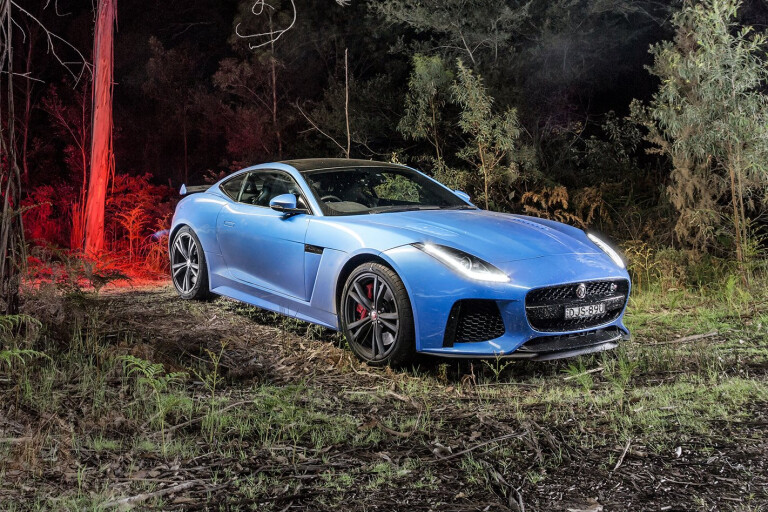
I’M SEATED in a modest farmhouse in a remote part of Tasmania we’ve been asked not to disclose.
Opposite me sits a man whose surname we’ve also been asked not to publish. Andrew, as we’ll call him, looks a bit older than his 50 years, with a tousle of blond hair that looks as if it’s on loan from a faded ’80s rock star. He produces a snap-lock plastic bag containing a rocky white substance. “Ere ya go,” he says, looking me in the eye. “Check it out; ’av a whiff.”

Now, over the years I’ve been offered many fun things to sniff by colourful characters, some of them producing quite pleasant sensations. But the calcified turd of an allegedly extinct marsupial has never been one of them. “That whispy bit on the end; that’s uniquely Tiger,” Andrew explains, as if I may be familiar with more mainstream marsupial turd formations.
Andrew, as you’ve probably figured, is a Tiger tracker. He’s made it his life’s work – an self-confessed obsession, even – to accumulate evidence that the allegedly extinct Tasmanian Tiger does still exist in tiny numbers in the remote north-east of the state. However, it’s Andrew’s photos, more so than his impressive scat collection, that really gets my attention.
But I’m getting ahead of myself…
I’D HEARD on the thylacine grapevine (okay, internet) that this dairy farmer from Tassie’s north-east had been tracking Tigers for more than 30 years. Andrew was a low-profile character, due in part to intimidation and ridicule from parties pushing an entirely contrary agenda, which we’ll get to. But he agreed to speak to us, and show us evidence that the official extinction line was in fact, bullshit.

To rendezvous with Andrew, we needed a car that would do justice to Tassie’s epic roads, but still have room for our gear and a layer of touring civility for when we needed to use the main highway. Obviously a naming synergy is always nice when planning these adventure drives, but sadly Sunbeam declined our request to reissue a Tiger with a supercharged V8.
Option B? A quick cat to track down a Tiger. Jaguar’s F-Type SVR Coupe nails the brief like a sprung bear-trap around a thylacine’s hind quarters.
It’s not just the quickest F-Type on offer, but the fastest production Jag since the XJ220 of 1992. The blown 5.0-litre is tweaked to push out 423kW and 700Nm, 0-100km/h is cut to 3.7sec, and top speed runs to a nice round 200mph (322km/h). The chassis is retuned via a lighter front anti-roll bar and stiffer one at the rear, as well as revised spring rates and damper valving. There’s also an exhaust system made from inconel (a nickel-chromium alloy) and titanium.
Add an active rear spoiler, more rear-biased AWD system, obligatory carbon bits and Alcantara trim, and watch the price also surge; up to $289,000, or about $44K more than the regular AWD F-Type R Coupe. Options include a weight-saving carbonfibre roof and carbon brakes, neither of which are fitted to our car. No deal-breaker, trust me.
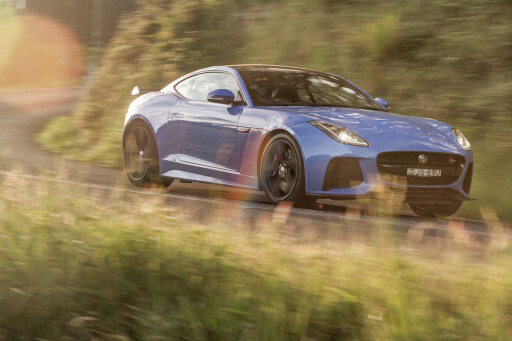
ANDREW has been considerate enough of visitors like us to perch his home in lush pastoral country just off an epic backroad we’ve agreed not to disclose. Suffice to say its plunging, snaking topography is like a giant set of roller-coaster rails under the Jag’s upsized Pirelli P Zero rubber (now 305/30 rear; 265/35 front).
But the moment we get some clear air off the Midlands Highway and ask the blown V8 to show what it’s got, the odds of a chance encounter with a thylacine plummet to zero. With the SVR’s switchable exhaust in the open position, this thing thunders like the end of days, and any Tigers within a five-kay radius would surely dive for their lairs or busy themselves writing stern letters of complaint to the local council.
The regular F-Type R is hardly a shy, retiring type, but the SVR is properly bad-ass; a gunslinger in the 911 Turbo vein, albeit cut from weightier GT cloth. There’s a percussive quality to the exhaust note low in the rev range, then it crackles wickedly as 4000rpm approaches, spinning into a volcanic on-cam zone to the 6600rpm cut-out. Jump onto the brakes and there’s an over-run cacophony that sounds like an irate Bunnings customer pushing over shelves in the paint department. It’s properly epic.
Superchargers may be deeply out of favour these days, but a blown V8 remains a thing of unbridled pleasure. You get boosted shove early, a turbo-esque monster mid-range, but without the sonic dulling down caused by sticking those impeller blades in the throat of the exhaust manifold.
This road serves up nothing slower than 55km/h advisory signs on its hundreds of corners, which the Jag slices through at comfortably double that. Yet all the while, I’m relating to the thylacine in ways I’d not previously thought possible.
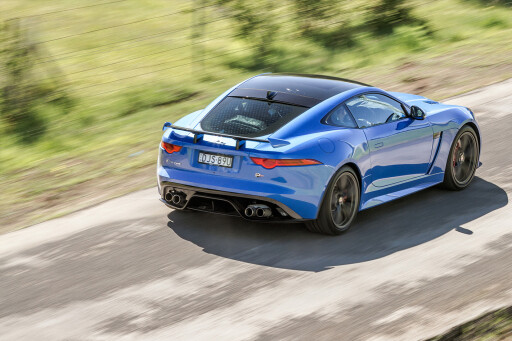
Last century, it was hunted into (alleged) extinction thanks in large part to zealous officers of the state government. A generous bounty was placed on the head of each animal for reasons relating to public menace and livestock preservation. Now, more than 70 years on, here I am in a near-600 horsepower Jaguar and every time I dare to let it off the leash, zealous officers of the state government want to hunt me down. The size of the bounty on my head rises with every 10km/h increment. Tassie officialdom would like me, my licence and our brilliant, barking, borderline-ballistic Jaguar to be struck on the extinction list.
As we head north-east on this sensational road, AC/DC’s seminal ‘Back in Black’ comes on the powerhouse Meridian Audio’s DAB, and it’s hard not to smile as Brian Johnson thunders the line: “They’re gonna have to catch me if they want me to hang…”
LATER, out the front of Andrew’s place − impossible to miss thanks to the wrought-iron cut-out of a Tiger’s silhouette hanging over his letterbox − we position the SVR for a photo as its precious-metal exhaust pings and ticks, and the massive brakes waft an acrid stink.
Andrew’s fleshy face breaks into a warm smile when he first takes in the Jag’s hunkered stance and carbonfibre rear wing. “So youse blokes bin havin’ a bit of fun; I can tell,” he offers by way of greeting. Once seated in his farmhouse, it’s Andrew’s photos, as I mentioned, that deliver the real slap in the face. They are prints taken by the many ‘trail cameras’ (triggered by heat and movement) he has set up; the most recent date-stamped 2014.

I view them through a magnifying glass, and see what can only be a thylacine. The head is utterly distinctive, the stripes unmistakable, the girth of the animal wider than I expected. “You’re used to the ones in the old zoo footage; they were skinny bastards coz they were fed the wrong diet,” Andrew explains.
I’m left pondering if the bloke is a fraudster knocking this stuff up in Photoshop, or peddling someone else’s hoaxes as his own. That seems impossible, given the shambolic state of his house, the lack of a decent computer and the fact I can tell he has little IT ability. Besides, he’s clearly not in this for personal gain. He’s spent a fortune over the years on fuel, batteries, cameras and prints, yet made nothing. No $100K exclusive with 60 Minutes.
So I reckon he’s fair dinkum, and I’m looking at proof of an animal the Tassie government says was wiped off the face of the earth way back in 1936.
What’s just as sobering is the price Andrew has paid, emotionally and socially, for his 30-year obsession. He tells me it’s cost him his marriage − “Yep, the missus just couldn’t deal with the time I was spendin’ away from the kids and the farm” − as well as friendships in his small town. “People will talk to ya about it, but then ya hear ’em sneering behind yer back, takin’ the piss like you’re a fuggin’ crackpot.”
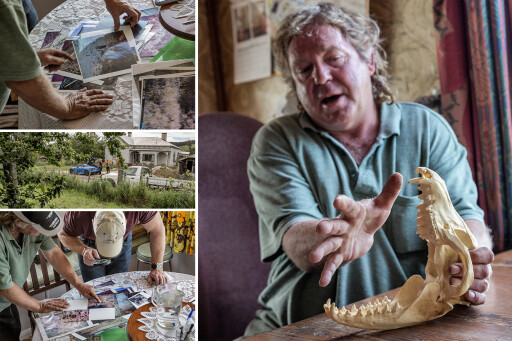
Then there’s the alleged cover-up by people in high places. “I’ve had a bloke from Parks and Wildlife tell me they know there’s up to 100 of ’em scattered across the north-east, but they don’t want people ta know,” he says. “I’ve been told to keep me nose out of it.”
He reckons his house was broken into − a neighbour saw a black SUV in his driveway on the afternoon in question − and photos and a threatening, unsigned official letter were stolen. “The government doesn’t want this to get out,” he says. “If they admit there’s a critically endangered animal living’ in these parts, that’d put pressure on ’em to stop logging and land clearing. They don’t want that. That shit costs big money, jobs … and votes.”
ANDREW could talk thylacines until the next ice age, and I could listen, but we need to head west to check out our next Tiger hot spot of Mole Creek. There’s a pub there that we’re told is like a shrine to all things thylacine, and the co-publican is a credible sighting witness. Plus they serve cold, locally brewed Tiger Ale on tap, and the Jag’s sat-nav is estimating we’ll arrive bang on beer-o’clock. Outta here...
Holding the SVR wide open for just 10 or so seconds is to be graphically reminded how indecently quick the thing is. It will bolt to the imperial ton (160km/h) in 8.0sec flat, and nail 0–160km/h–0 in just 13.2sec. The linear, punchy bottom end grabs your attention and the surging mid-range keeps you focused, yet there’s no tailing-off up top, making the 6600rpm cut-out a fraction disappointing. There’s no logical need for it to rev beyond that, but if it did, this engine would get a billing in my all-time top five.

As we hammer along some deserted but lumpen backroads, the chassis starts to get a little flustered in the regular driving mode at these speeds. There’s a bit of high-frequency pogoing that’s fixed with a switch to Dynamic mode; instantly the body feels hunkered down and that first restless 20mm of suspension travel is sucked out. Of course the ride tightens, but there’s no discomfort; no hint of bottoming or crash-through. It’s like snugging down the straps of a flak jacket as you charge into battle. The exhaust flaps open automatically in Dynamic, but can be closed with the press of a separate switch. We keep them open.
Before driving it, I’d wondered if the SVR wicking-up process may have robbed the F-Type of its GT ability; if it may now be a bit stiff and loud and aggro to allow properly relaxed cruising.
Clearly I worry too much. All those qualities survive intact; you can surf around plucking gears and keeping the engine below 2000rpm and gurgling like a distant, contented feline. Around town, there’s minimal jostling and surprising civility. Only loud tyre roar on coarse-chip takes the edge off the interstate express tranquillity. The steering, too, is terrific. It’s retuned in the SVR for less assistance at speed, and has a lovely, wriggly analogue tactility and nuance, despite being electrically assisted. It reminds me, curiously, of a 997 Porsche 911, the way it gives delicate, measured feedback when loaded up.
THE shadows are long when we arrive at the tranquil little town of Mole Creek (‘Tiger Territory’, the sign proclaims) to find publican Doug Westbrook unloading cases of beer into his pub’s cool room. He tells us it was his wife Ramona who saw one, at the edge of a road, it was, back in 1999. Since then there have been a number of other credible sightings − and no doubt plenty of bogus ones from attention-seeking whackballs − all of whom are enshrined via framed newspaper clippings of the walls of the Tiger Bar. They take it all a bit less seriously here, as evidenced by the mural of sexy, bare-breasted female Tigers that look like Tony the Frosties tiger crossed with Pamela Anderson. The pub’s pies, decorated with a wonderfully detailed pastry cutout of a Tiger, are delicious, even if they are made with regular beef, and not genuine thylacine. I stop at just one of the excellent Tiger Ales; a few more and I reckon I’d be seeing multiple thylacines doing the funky-chicken strut down the main street.

At dusk, we nurse the Jag down a remote trail about 10 kays outside of town. Thomas wants to take car photos; I want to spot a Tiger, and this is prime territory. As darkness envelopes us, the silence gives way to occasional rustles and chirps from deep in the undergrowth. Then I hear it: a high-pitched howl, then a hacking, barking, angry sound of confrontation. It’s not a noise I’ve ever heard before. Could this be it? Is this my Tiger moment?
I shine the torch. No, it’s just Wielecki, the mad Pole, dealing with a painful zipper malfunction after taking a leak. Ouch. At least the car looks awesome bathed in blinding white LED light.
THE NEXT day, back in Launceston, we stop outside the town hall. There we spot a cast relief of the city’s coat of arms set near the building’s grand columns. It depicts two chained Tassie Tigers rearing up at a bird. The motto implores ‘Progress with Prudence’.
It’s a telling message of good intentions versus real-world realities. Plenty of Greens supporters and environmentalists would argue that Tasmania’s ‘progress’ has involved more pillage than prudence, given the felling of old-growth forests and rampant woodchip industries. And let’s not get started on dams.
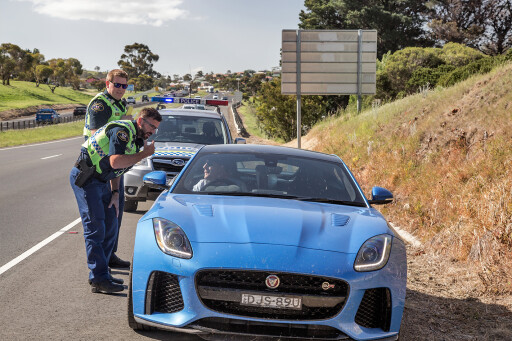
As for the fate of the Tiger, my mind drifts back to some early footage I’d watched on YouTube. Shot in shaky black and white in 1933 at the Hobart Zoo, it stands as the last undisputed footage of the animal. It depicts a very different, far more primitive Australia. The captive creature in question was apparently named Benjamin, but I suspect he didn’t answer to that. Hopefully, despite the obvious indignity of his captivity, he still had the fortitude to demand to be called by his formal Latin name, Mr Thylacinus Cynocephalus. Maybe he’d cop ‘Thylo’ for short on his better days. But not bloody Benjamin.
For reasons I can’t fully explain, it makes me feel just a little less hopeless for the future of the planet to know that Benjamin was not, in fact, the very last of his species.
Three days earlier, I’d arrived in Tassie fairly cynical of the Tiger’s reported existence. I leave this complex little island far less cynical, but also uplifted. Then again, maybe Tasmania’s roads and the abilities of the F-Type SVR could turn just about anyone into a believer.


COMMENTS